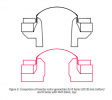Because the instrumentation there is very precise. Not so with acoustic measurements involving microphones, room noise, non-linearities, etc.
If the agreement between your own relative measurements is +-1.5dB due to room noise then you should stop publishing measurements until you fixed that. But it isn't. It's much higher and it seems to me like we're not on the same page with what we're talking about. Again, this is a
relative measurement. Relative to your own measurement. The microphone could be an SM58 and the relative agreement between measurements like this will still be good.
When you have bass distortion in full percentage points, you could just be looking at distortion products and not anything remotely related to "compression." Such louder SPL tests could also cause room noises, etc. that distort the results.
This is not the case for active speakers with transparent limiters. The speaker could be 10dB into compression without audible distortion.
If you say the louder SPL tests cause room noise, which then muddies the results, then the distortion plots you publish are also incorrect. And then, if the room noise is an issue, is it too much to ask to fix those kind of issues? When you have a 100k measurement system? I'd volunteer to help with that task, if I wasn't on a different continent.
Really, if you care about audibility of frequency response due to SPL, then you must follow the 50 dB rule and not zoom in more. If I showed you even the best speaker response at 20 dB SPL, it would look bad.
Most of the other graphs are not adjusted to show the data in a psychoacoutically representative way, but to make the comparison between devices easier. If you went with this rule for everything, you'd have to stop publishing any kind of DAC distortion data, because it's all inaudible. Publishing data in a more user friendly format is always a good thing. And I'm repeating myself, but if someone misinterprets the data because it's easier to see in the graph than it is to hear in practice then I'm sure someone on here will step in and correct that misguided assumption.


